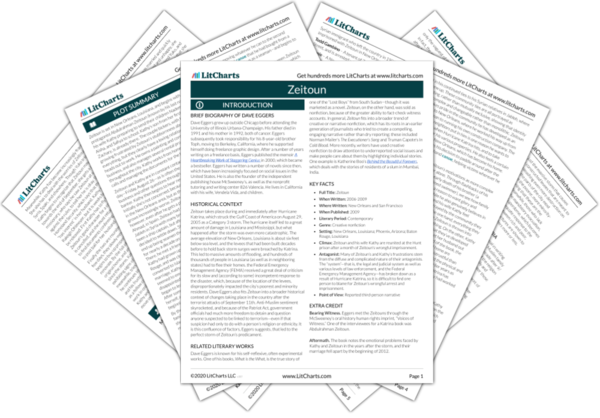Summary
Analysis
In the morning four African-American men are added to the cell. There’s not room for all of them to sit, so they rotate every hour. They had been picked up in New Orleans after the storm, two of them in situations like Zeitoun’s. One of them was a sanitation worker from Houston, whose company had been contracted to begin the cleanup after the storm. He was picked up and handcuffed while returning to his hotel one day, and seems the most bemused of all of them. It made no difference that he was in uniform and had his ID and keys to his truck—he was still charged with looting.
As the men swap stories, it becomes clear that Zeitoun’s case is not an isolated one, but rather an example of broader dysfunction and breakdown of legal justice in the days after the storm. It seems that racial prejudice is at play here as well, with authorities choosing to believe that one of the black men must be a looter even despite clear, obvious evidence to the contrary. The media’s racially-biased portrayals of “looting” here have personal and devastating effects.
Themes
Zeitoun learns that many of the men had been brought to a makeshift court in the office at Camp Greyhound with a judge and at least one lawyer, were told their charges, and offered a deal: if they didn’t contest the charges, they’d get a misdemeanor and would have to perform community service. Some who accepted this were immediately brought to the police station downtown to begin repairing the offices.
Unlike Zeitoun, many of these men actually did participate in some semblance of a court hearing, but it seems that even this kind of hearing was more of a sham, meaning that innocent men could be tricked into confessing guilt in order to avoid the possibility of serving jail time.
Themes
Zeitoun’s pain in his side is growing worse and worse. He flags down the nurse who pushes a cart of medicine through the cellblock once a day, and she says he’ll have to see the doctor. She gives him the form, which he fills out and hands back to her.
In addition to the broader problem of his imprisonment, Zeitoun now has to deal with a specific physical issue, one made far more complicated by his situation.
Themes
That evening, the prisoners swap stories they’ve heard. The thousands from Orleans Parish Prison, including many imprisoned for misdemeanors like shoplifting and public intoxication, had been left on an overpass for three days, sitting in their own excrement and garbage, surrounded by guards with automatic rifles. They were then brought to the football stadium where they were held without any kind of shelter for days, murderers and rapists together with DUIs. There were no bathrooms, pillows, or dry clothing.
The stories shared by some of these prisoners provide shocking examples of the breakdown in the social fabric of New Orleans after Hurricane Katrina. There was a failure in basic human rights for prisoners, as well as a failure to understand the implications of clearly last-minute decisions like housing the entire prison population in one undersupplied place.
Themes
Get the entire Zeitoun LitChart as a printable PDF.













